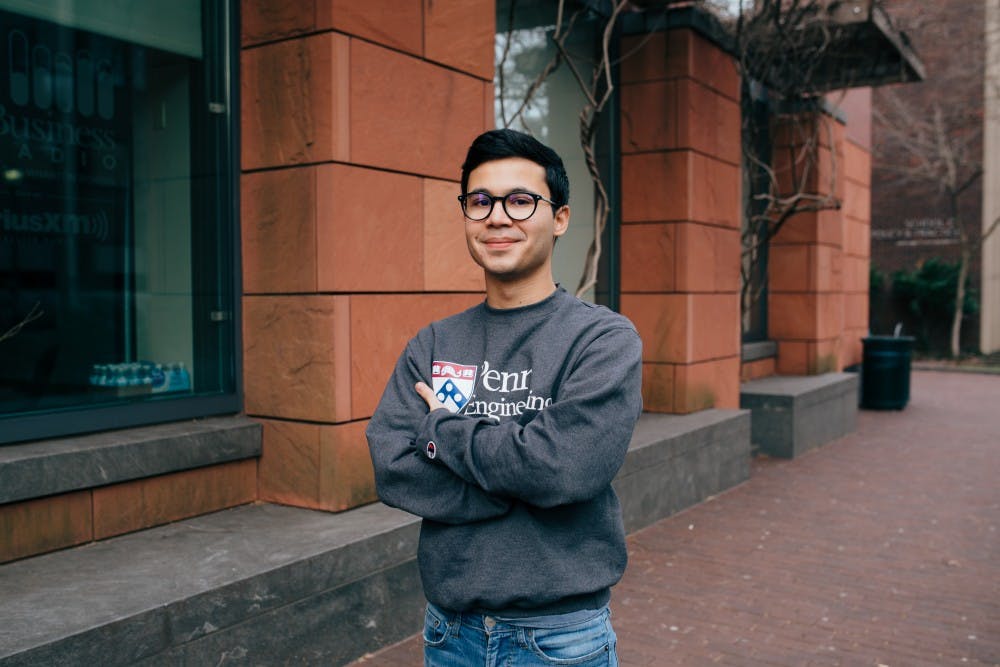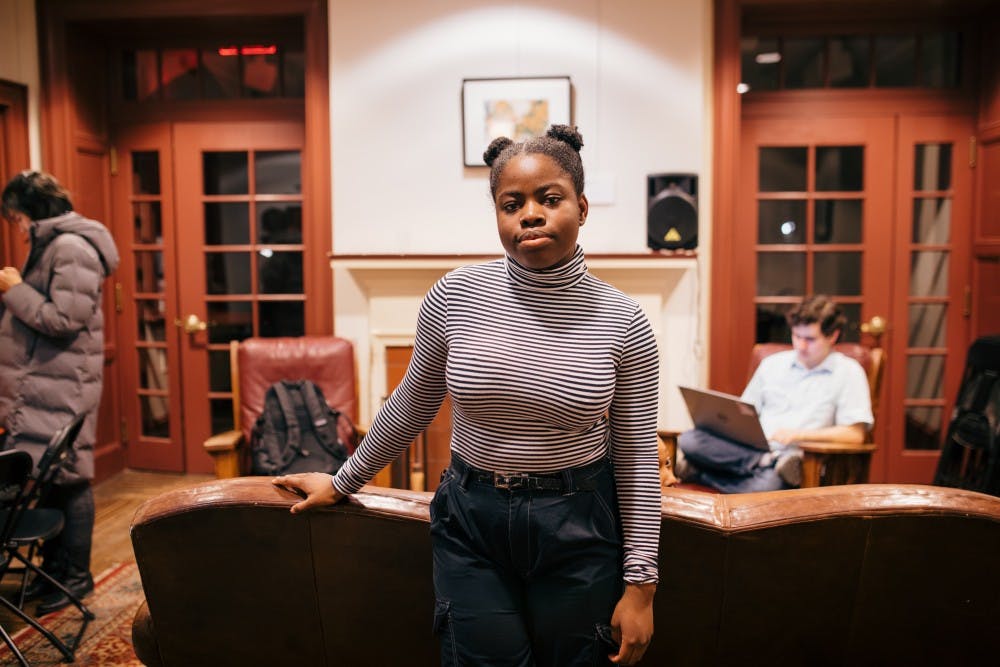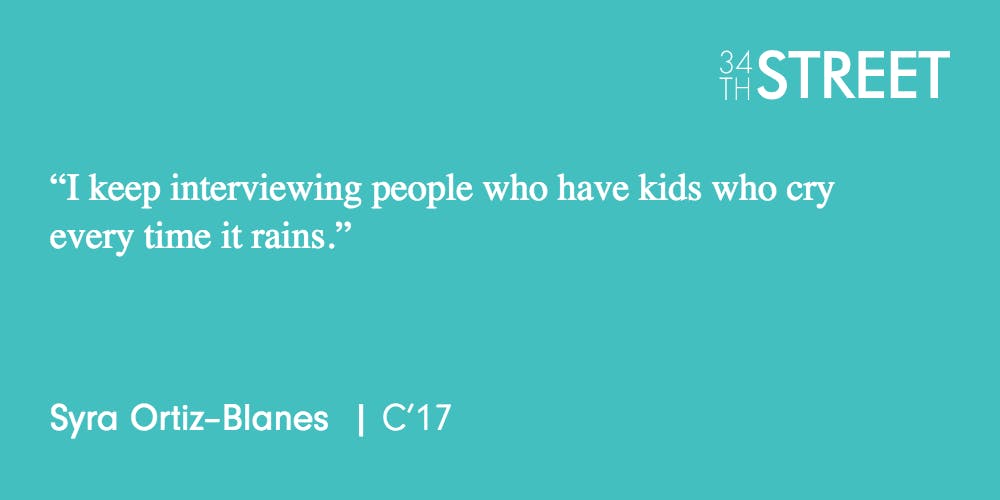It was a week after Hurricane Maria hit Puerto Rico, and Emmanuel Suarez Acevedo (E’19) thought his parents might be dead. He spent “every waking moment looking up information on Puerto Rico to see if they heard anything about my hometown, seeing images of my hometown completely destroyed. Places that were just a two minute drive away from me, completely flooded, that [made me] wonder … ‘Is my house completely flooded? Are my parents literally underwater right now, waiting for someone to find their bodies?’”
Hurricanes are an expected part of life in Puerto Rico. Emmanuel notes that Hurricane Irma, which hit the island on Sept. 6th, 2017, was “especially bad.” Nevertheless, his family and other Puerto Ricans “were mostly back on their feet after a while.” Only two weeks later, Hurricane Maria struck. Upon making landfall on Sept. 20th, 2017, Maria’s powerful winds knocked out power for the entire island and were accompanied by massive floods. Both forces combined to destroy Puerto Rico’s infrastructure and millions of homes. “My mom said she had never heard anything so scary as the time she was in the actual heat of the hurricane,” Emmanuel says. “She could swear the world was literally being destroyed outside. She was expecting to see nothing except her house.”
Along with carrying that anxiety, Emmanuel still had to be a student. “I was simultaneously trying to study for exams, while simultaneously interviewing, because I was also recruiting for jobs for that summer at the same time, and simultaneously trying to figure out financial aid, because I needed to pay rent soon, and I didn’t have money to pay my rent,” he says.

Between hurricanes in the Atlantic, deadly heat waves in Europe and Australia, and earthquakes in southeast Asia, the world has seen an alarming rise in natural disasters in the past few decades, dating back to the 1970s. In 1966, there were 80 natural disasters, while in 2018 there were 282. For Penn students far from home, the effects can range from sudden financial difficulties to secondary trauma. Despite the policies and resources available at Penn, facing natural disasters during the course of a semester can be a lonely, frightening challenge.
According to the Division of the Vice Provost for University Life (VPUL), Penn staff are tasked with identifying and reaching out to affected students as quickly as possible in the event of a natural disaster.
Emmanuel, however, says he was not contacted by an administrator immediately after Maria began, although he did get in contact with administration via email nine days later. “Immediately after this happens I should not be expected to jump through hoops to get basic help,” he says. “I should be reached by Student Financial Services or Student Intervention Services, saying, ‘Hello, we realize that you’ve had this life changing disaster happen. What do you need to get through the semester, what do you need to get through the week?’ And letting my professors know, so my professors be aware of my situation, and each of them can act accordingly.”
Although hurricanes are also a normal part of life in Florida, for Mary Osunlana (C’20), who has lived in Fort Lauderdale since she was seven, Hurricane Irma was more concerning. With its 185 mph winds and record duration as a Category 5 hurricane, Irma is considered one of the most powerful hurricanes to ever form in the Atlantic Ocean.
“We have our hurricane season which is around when school starts, so usually I’m not thinking too hard about hurricanes,” Mary says. “So when I hearing the first inklings about it, I didn’t think too much of it. But eventually it was supposed to be something serious, so I started calling my parents and making sure that they were getting everything together for that.”

Even from afar, knowing that loved ones are experiencing a hurricane is stressful. “It’s just nerve wracking, because there’s literally nothing you can do,” she says. She compared to when she had been to a shelter in a basement of a hospital when she was younger where all she could do was wait, following a deadly hurricane, but it is all the more frustrating when far away. She describes feeling “fear for anything could happen, even though I knew my area, Broward County, was on the outskirts of the eye of the storm. You just never know how intense or what would happen in a storm like that.”
Mary’s house and family suffered no serious damage. Generally, she and her family haven’t been seriously affected by these natural disasters. But Mary worries for the future, especially given the rising incidence of natural disasters and looming effects of climate change. “I can imagine a future where there’s a worse hurricane,” she says. “Me and my brother talk about how Florida will be underwater in like fifty years, and so we just live with natural disasters being imminent at any point in Florida.”
The staff at the Kelly Writers House, where she works, reached out to her. She also, like all Penn students, received the Penn administration’s email expressing their “deepest sympathies” for those affected by Irma.
Like hurricanes in Florida and Puerto Rico, California fires are “an expectation,” according to Thousand Oaks native Vasant Iyer, a second year PhD student in Engineering. However, on Nov. 7, 2018, a devastating wildfire, known as the Woolsey Fire, caught fire for weeks. Vasant says that of the fires he’s experienced, “none have ever been this close.” While his home and family were safe, hiking trails and a camp he used to go to with his orchestra were burned down. “[I] was just following that on the news, looking at the maps of where the fire is spreading, and thinking about, ‘Oh, what’s not gonna be there when I go home?’”
“No one is not affected by that,” he says of the fire, which burned 97,000 acres and can be seen from space. “There’s so much smoke from the fire that the sun is obscured, and it looks blood red, and there’s ash is [sic] raining down.”

For Vasant, having some labmates and friends that knew he was going through something difficult was helpful. “People were aware that it was something I was going through, and that recognition from my classmates and friends was good enough for me,” Vasant says, though he adds he might have wanted more support from Penn had he or his family been directly affected by the fire.
According to Penn Today, following Hurricane Irma, Student Intervention Services and the Registrar’s Office worked together to identify affected students and “notified each school to initiate student outreach.” Student Intervention Services redirected a request for comment to VPUL.
In an emailed statement, Monica Yant Kinney, the chief of staff and chief communications officer in VPUL, wrote that “generally, in the event of a major natural disaster, Penn staff quickly try to identify students from that state or country. … The student’s school—an academic advisor—does the initial outreach out to students from an area affected by a natural disaster.”
She acknowledged that locating students was “an imperfect science,” and students may not be contacted for a variety of reasons. For instance, if their permanent home address in the university system did not reflect where the student spent their formative years, or they lived with one parent and the other parent was affected, they may be missed. VPUL reiterated that Penn encourages students to share the news with academic advisors or staff as soon as possible.
Meeta Kumar, deputy executive director of CAPS, echoes the sentiment. “We work very closely with the university’s central resources when any student or any community is impacted by any sudden, stressful, traumatic events in their life … CAPS is part of the first responder team,” she says.
Kumar added that CAPS takes on an active role beyond providing psychotherapy in cases where students need help navigating Penn. “If students are being identified, we will do proactive outreach, as well as just accommodate student needs in a variety of different ways. And we also take on an advocacy role to assisting students, [whether] they need academic support, [or] any other kind of travel or funding assistance.”
As in Emmanuel’s case, students’ financial situations are often impacted by natural disasters, which causes an additional mental health burden. There is a well–documented cyclical relationship between mental health and poverty, with wide-ranging effects, from impaired cognitive abilities to affecting brain development for youth living in poverty.
When a natural disaster occurs, two opportunities arise with respect to financial aid. First, according to SFS Senior University Director of Financial Aid Elaine Papas–Varas, there’s the federal government’s role, as it funds higher education institutions in many different ways, from direct loans to work study. “When there’s natural disasters, the first thing the federal government does is reach out to the schools to say ‘We understand that you are going to have students who may have experienced Hurricane Floyd or an earthquake. And we are here, and we prepared to offer a number of things to make it less stressful.’” This ranges from providing an extension on the FAFSA to processing a Pell grant for someone who normally does not receive one.
Then, within Penn, any student can file a revaluation form to explain their circumstances and request a change in financial aid. The form must be completed for any adjustment to a student’s financial aid, according to Varas, for the students protection. “We want to be sure that we cover all of our bases, and in that way we can cover all the potential expenses.” Varas asserted that this issue was “very important” in staff trainings.
While Varas declined to comment on Emmanuel’s case specifically, she reiterated that “every students’ circumstances are unique and different” and emphasized the importance of students “[finding] a way to get to this office. We really are here to help.”
Syra Ortiz–Blanes (C’17) is an alumna from Puerto Rico who writes for The Philadelphia Citizen and formerly wrote for 34th Street. In fact, when Maria made landfall, it was Syra’s first day of work. Although Syra had already graduated from Penn, she was still in contact with other Puerto Rican students who were affected. She believes Penn should have offered free tuition to Puerto Rican students, like peer institutions such as Brown did. “Considering Penn’s ties to the Puerto Rican community in Philadelphia and to Puerto Rico, Penn receives so many students from Puerto Rico, and it’s such an active alumni base … Penn as an institution should have taken more responsibility.”
For Syra, natural disasters are also inseparable from politics. “You can’t talk about Maria without talking about Puerto Rico’s political status, you can’t talk about Maria without talking about Puerto Rico’s economic crisis, and you can’t talk about Maria without talking about the lack of autonomy and agency that Puerto Rico had in taking care of itself, for example,” she says. She adds that after María, the denial of climate change feels even more personal. “It’s not a question of morality, it’s a question of life and death … And if you deny climate change, that blood is on your hands.”

Syra was stranded in Puerto Rico during Irma while visiting family. She describes Irma as being “a pretty standard hurricane. It was something that I had gone through before.” But, María was different. “I woke up, had a bunch text messages from my mom. She had been narrating for the past couple of hours the storm. She sent me texts and videos, and all the sudden they just stopped at around 7:30, and I just burst out into tears when I saw that.”
In the following days, while she was moving into her new apartment, “people back home were dying because they were drinking from streams that were contaminated… because they had no other choice… It was a combination of survivor’s guilt with pure agony, grief, that everything I knew didn’t exist anymore as I knew it.”
In the wake of the hurricane, Syra created Las voces de María, a multimedia journalism project created with photographer Cameron Hart, which documents the experiences of survivors recently arrived in Philadelphia. The project was exhibited at the Kelly Writers House in October 2018.
“The amount of grief, anxiety and uncertainty from natural disasters and related to climate change, is enormous,” Syra says. “I keep interviewing people who have kids who cry every time it rains.”
Emmanuel, like Syra, still lingers on the memory of María, even though many months have passed since the aftershock. In all aspects, his story ended well. His financial aid was increased, his school was notified, and he says he managed to get by. He is now a senior, just a few months shy of graduation.
But when the news first came, all he wanted to do was leave. “It felt ridiculous to be here doing things that truly didn’t seem to matter in the grand scheme of things, when my entire family was suffering so much.”
Katrina Janco is a senior studying Communication from Audubon, NJ. She is a Features Writer for Street. Haley Suh contributed reporting.
